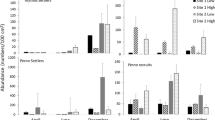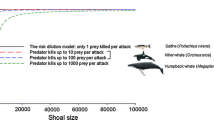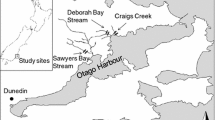Summary
The mussel Mytilus edulis typically occurs in aggregations and several consequences of living in groups were studied. Isolated individuals and individuals associated in relatively small groups (6–9 mussles/group) grew more and therefore had greater reproductive output than mussels associated with relatively large groups of 21–28 individuals. Mussels located in the centers of groups exhibited reduced growth and thus lower reproduction relative to mussels located on the edges of groups whose growth and reproduction was similar to that of isolated individuals. Sampling from natural populations indicated that most mussels grow within the matrix of very large groups and hence will experience reduced growth and reproduction. Patterns of growth exhibited by mussels in association with living and model mussels showed that the adverse effects on growth exhibited by mussels in relatively large groups are not a function of the mere physical relief of a mussel clump, but are caused by some property of living neighbors.
Laboratory experiments on mussel predation by the crab Pachygrapsus crassipes indicated that crabs prey disproportionately on mussels growing on the edges of groups.
The consequences of group living in mobile and nonmobile organisms are considered, and it is suggested that a greater number of negative effects will arise in groups as mobility decreases. In addition, the noted ecological similarity between groups of sessile organisms and spreading clones and its evolutionary implications are discussed.
Similar content being viewed by others
References
Barlow GW (1974) Extraspecific imposition of social grouping among surgeonfishes (Pisces: Acanthuridae). J Zool 174:333–340
Barnard CJ (1980) Flock feeding and time budgets in the house sparrow (Passer domesticus L.). Anim Behav 28:295–309
Beiswinger RE (1975) Structure and function in aggregation of tadpoles of the American toad, Bufo americanus. Herpetologica 31:222–233
Bertness MD, Grosholz E (1985) Population dynamics of the ribbed mussel, Geukensia demissa: the costs and benefits of an aggregated distribution. Oecologia (Berlin) 67:192–204
Brett JR (1979) Some morphological and behavioral adaptations of pile perch (Rhacochilus vacca) feeding on mussels (Mytilus edulis). Can J Zool 57:658–664
Buskirk RE (1975) Coloniality, activity patterns and feeding in a tropical orb-weaving spider. Ecology 56:1314–1328
Buss LW (1981) Group living, competition, and the evolution of cooperation in a sessile invertebrate. Science 213:1012–1014
Dayton PK (1971) Competition and community organization: the provision and subsequent utilization of space in a rocky intertidal community. Ecol Monogr 41:351–389
Ebling FJ, Kitching JA, Muntz L, Taylor LM (1964) The ecology of Lough Ine. XIII. Experimental observations of the destruction of Mytilus edulis and Nucella lapillus by crabs. J Anim Ecol 33:73–82
Frank PW (1965) The biodemography of an intertidal snail population. Ecology 46:831–844
Fréchette M, Bourget E (1985) Food-limited growth of Mytilus edulis L. in relation to the benthic boundary layer. Can J Fish Aquat Sci 42:1166–1170
Gochfeld M, Burger J (1981) Feeding enhancement by social attraction in the sandwich tern. Behav Ecol Sociobiol 10:15–17
Gross MR, MacMillan AM (1981) Predation and the evolution of colonial nesting in bluegill sunfish (Lepomis macrochirus). Behav Ecol Sociobiol 8:163–174
Harger JRW (1972) Competitive coexistence: maintenance of interacting associations of the sea mussels Mytilus edulis and Mytilus californianus. Veliger 14:387–410
Hobson ES (1978) Aggregating as a defense against predators in aquatic and terrestrial environments. In: Reese ES, Lighter FJ (eds) Contrasts in behavior: adaptations in the aquatic and terrestrial environments. John Wiley and Sons, Inc., New York, pp 219–234
Hoogland JL (1981) The evolution of coloniality in white-tailed and black-tailed prairie dogs (Sciuridae: Cynomys leucurus and C. ludovicianus). Ecology 62:252–272
Hoogland JL, Sherman PW (1976) Advantages and disadvantages of bank swallow (Riparia riparia) coloniality. Ecol Monogr 46:33–58
Jackson JBC (1977) Competition on marine hard substrata: the adaptive significance of solitary and colonial strategies. Amer Nat 111:743–767
Jôrgensen CB (1966) The biology of suspension feeding. Pergamon Press, Oxford, p 337
Jôrgensen CB (1981a) A hydromechanical principle for particle retention in Mytilus edulis and other ciliary suspension feeders. Mar Biol 61:277–282
Jôrgensen CB (1981b) Feeding and cleaning mechanisms in the suspension-feeding bivalve Mytilus edulis L. Mar Biol 65:159–163
Kautsky N (1982) Growth and size structure in a Baltic Mytilus edulis population. Mar Biol 68:117–133
Kitching JA, Sloane JF, Ebling FJ (1959) The ecology of Lough Ine. VIII. Mussels and their predatiors. J Anim Ecol 28:331–341
Lissamen PBS, Schollenberger CA (1970) Formation flight of birds. Science 168:1003–1005
Maas Geesteranus RA (1942) On the formation of banks of Mytilus edulis L. Archs Neerl Zool 6:283–326
Major PF (1978) Predator-prey interactions in two schooling fishes, Caranx ignobilis and Stolephorus purpureus. Anim Behav 26:760–777
Menge BA (1976) Organization of the New England rocky intertidal community: role of predation, competition, and environmental heterogeneity. Ecol Monogr 46:355–393
Neill SRStJ, Cullen JM (1974) Experiments on whether schooling by their prey affects the hunting behaviour of cephalopods and fish predators. J Zool 172:549–569
Okamura B (1984) Functional and ecological consequences of aggregation and coloniality in benthic, marine suspension feeders. PhD. dissertation, University of California, Berkeley, CA, p 159
Okamura B (1985) The effects of ambient flow velocity, colony size, and upstream colonies on the feeding success of Bryozoa. II. Conopeum reticulum (Linnaeus), an encrusting species. J Exp Mar Biol Ecol 89:69–80
Paine RT (1974) Intertidal community structure: experimental studies on the relationship between a dominant competitor and its principal predator. Oecologia (Berlin) 15:93–120
Pennington JT (1985) The ecology of fertilization of echinoid eggs: the consequences of sperm dilution, adult aggregation, and synchronous spawning. Biol Bull (Woods Hole, Mass.) 169:417–430
Powell GVN (1974) Experimental analysis of the social value of flocking by starlings (Sturnus vulgaris) in relation to predation and foraging. Anim Behav 22:501–505
Robertson DR, Sweatman HPA, Fletcher EA, Cleland MG (1976) Schooling as a mechanism for circumventing the territoriality of competitors. Ecology 57:1208–1220
Seed R (1969) The ecology of Mytilus edulis L. (Lamellibranchiata) on exposed rocky shores. I. Breeding and settlement. Oecologia (Berlin) 3:277–316
Siegfried WR, Underhill LG (1975) Flocking as an antipredator strategy in doves. Anim Behav 23:504–508
Sokal RR, Rohlf F (1981) Biometry. Second edition. W.H. Freeman and Company, San Francisco, CA, p 859
Suchanek TH (1981) The role of disturbance in the evolution of life history strategies in the intertidal mussels Mytilus edulis and Mytilus californianus. Oecologia (Berlin) 50:143–152
Thompson RJ (1984) The reproductive cycle and physiological ecology of the mussel Mytilus edulis in a subarctic non-estuarine environment. Mar Biol 79:277–288
Underwood AJ (1976) Food competition between age-classes in the intertidal neritacean Nerita attramentosa Reeve (Gastropoda: Prosobranchia). J Exp Mar Biol Ecol 23:145–154
Ward P, Zahavi A (1973) The importance of certain assemblages of birds as “information centers” for food finding. Ibis 115:517–534
Wethey DS (1983) Intrapopulation variation in growth of sessile organisms: natural populations of the intertidal barnacle Balanus balanoides. Oikos 40:14–23
Wiklund CG, Andersson M (1980) Nest predation selects for colonial breeding among fieldfares Tudus pilaris. Ibis 122:363–366
Wilson BR, Hodgkin EP (1967) A comparative account of the reproductive cycles of five species of marine mussels (Bivalvia: Mytilidae) in the vicinity of Freemantle, W. Australia. Aust J Mar Freshwater Res 18:175–203
Witman JD, Suchanek TH (1984) Mussels in flow: drag and dislodgement by epizoans. Mar Ecol Prog Ser 16:259–268
Young G (1983) The effect of sediment type upon the position and depth at which byssal attachment occurs in Mytilus edulis. J Mar Biol Assoc UK 63:641–651
Author information
Authors and Affiliations
Additional information
This is contribution no 171 from the Smithsonian Marine Station at Link Port
Rights and permissions
About this article
Cite this article
Okamura, B. Group living and the effects of spatial position in aggregations of Mytilus edulis . Oecologia 69, 341–347 (1986). https://doi.org/10.1007/BF00377054
Received:
Issue Date:
DOI: https://doi.org/10.1007/BF00377054




